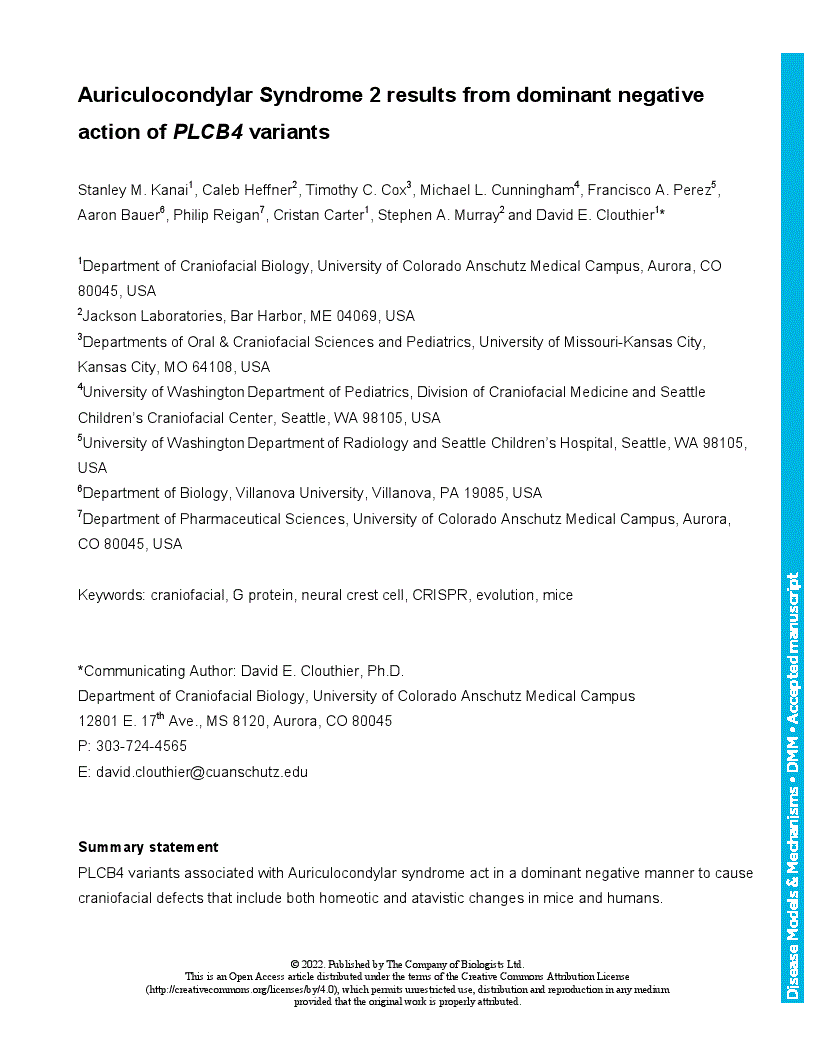Auriculocondylar Syndrome 2 (ARCND2) is a rare autosomal dominant craniofacial malformation syndrome linked to multiple genetic variants in the coding sequence of phospholipase C β4 (PLCB4). PLCB4 is a direct signaling effector of the Endothelin Receptor Type A (EDNRA)-Gq/11 pathway, which establishes the identity of neural crest cells (NCCs) that form lower jaw and middle ear structures. However, the functional consequences of PLCB4 variants on EDNRA signaling is not known. Here, we show using multiple signaling reporter assays that known PLCB4 variants resulting from missense mutations exert dominant negative interference on EDNRA signaling. In addition, using CRISPR/Cas9, we find that F0 mouse embryos modeling one PLCB4 variant have facial defects recapitulating those observed in hypomorphic Ednra mouse models, including a bone that we identify as an atavistic change in the posterior palate/oral cavity. Remarkably, we have identified a similar osseous phenotype in a child with ARCND2. Our results identify the disease mechanism of ARCND2, demonstrate that the PLCB4 variants cause craniofacial differences and illustrate how minor changes in signaling within NCCs may have driven evolutionary changes in jaw structure and function.
Auriculocondylar Syndrome 2 results from dominant negative action of PLCB4 variants
- Award Group:
- Funder(s): National Institutes of Health
- Award Id(s): DE025862-03S1
- Funder(s):
- Award Group:
- Funder(s): funder-list
- Funder(s):
- Award Group:
- Funder(s): Stowers Family Foundation
- Funder(s):
Currently Viewing Accepted Manuscript - Newer Version Available
Stanley M. Kanai, Caleb Heffner, Timothy C. Cox, Michael L. Cunningham, Francisco A. Perez, Aaron Bauer, Philip Reigan, Cristan Carter, Stephen A. Murray, David E. Clouthier; Auriculocondylar Syndrome 2 results from dominant negative action of PLCB4 variants. Dis Model Mech 2022; dmm.049320. doi: https://doi.org/10.1242/dmm.049320
Download citation file:
Advertisement
Sex matters in preclinical research

DMM calls for improved inclusion, analysis and reporting of sex as a biological variable in preclinical animal modelling research. Read the full Editorial by Monica J. Justice.
Subject collection: Building advocacy into research

DMM’s new series - Building advocacy into research - features interviews, ‘The Patient’s Voice’, with patients and advocates for a range of disease types, with the aim of supporting the highest quality research for the benefit of all patients affected by disease.
Travelling Fellowships for early-career researchers

DMM and its sister journals offer Travelling Fellowships of up to £3,000 to graduate students and post-doctoral researchers wishing to make collaborative visits to other laboratories. Find out more about our Travelling Fellowships and read stories from previous grant recipients.
Read & Publish Open Access publishing: what authors say

We have had great feedback from authors who have benefitted from our Read & Publish agreement with their institution and have been able to publish Open Access with us without paying an APC. Read what they had to say.
The Forest of Biologists
Our Publisher Claire Moulton recently visited the two Woodland Trust UK sites where we are planting new native trees for published Research and Review papers and protecting ancient woodland on behalf of our peer reviewers.
Other journals from
The Company of Biologists



